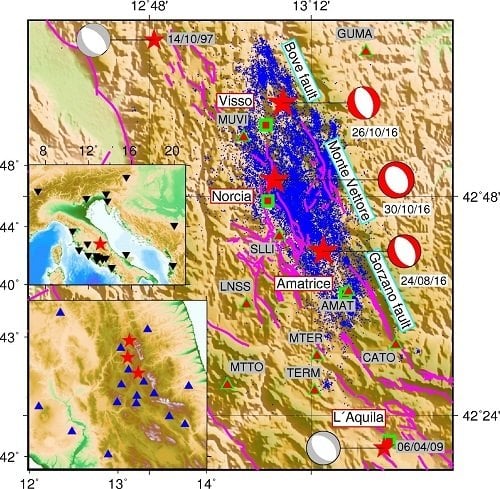Focal Mechanisms of the 2016 Central Italy Earthquake Sequence Inferred from High-Rate GPS and Broadband Seismic Waveforms
Abstract
:1. Introduction
2. Data and Methods
2.1. Broadband Seismograms
2.2. High-Rate GPS Records
2.3. Inversion Scheme
3. Results
4. Discussion
4.1. Sparce Network Tests
4.2. Source Parameters
4.3. Seismogenic Tectonics
5. Conclusions
Supplementary Materials
Acknowledgments
Author Contributions
Conflicts of Interest
References
- Emergeo Working Group. Coseismic effects of the 2016 Amatrice seismic sequence: First geological results. Ann. Geophys. 2016, 59. [Google Scholar] [CrossRef]
- Amato, A.; Azzara, R.; Chiarabba, C.; Cimini, G.B.; Cocco, M.; Di Bona, M.; Margheriti, L.; Mazza, S.; Mele, F.; Selvaggi, G.; et al. The 1997 Umbria-Marche, Italy, Earthquake Sequence: A first look at the main shocks and aftershocks. Geophys. Res. Lett. 1998, 25, 2861–2864. [Google Scholar] [CrossRef]
- Chiarabba, C.; Amato, A.; Anselmi, M.; Baccheschi, P.; Bianchi, I.; Cattaneo, M.; Cecere, G.; Chiaraluce, L.; Ciaccio, M.G.; De Gori, P.; et al. The 2009 L’Aquila (central Italy) MW6.3 earthquake: Main shock and aftershocks. Geophys. Res. Lett. 2009, 36. [Google Scholar] [CrossRef]
- Frepoli, A.; Amato, A. Contemporaneous extension and compression in the Northern Apennines from earthquake fault-plane solutions. Geophys. J. Int. 1997, 129, 368–388. [Google Scholar] [CrossRef]
- Akinci, A.; Galadini, F.; Pantosti, D.; Petersen, M.; Malagnini, L.; Perkins, D. Effect of Time Dependence on Probabilistic Seismic-Hazard Maps and Deaggregation for the Central Apennines, Italy. Bull. Seismol. Soc. Am. 2009, 99, 585–610. [Google Scholar] [CrossRef] [Green Version]
- Tinti, E.; Scognamiglio, L.; Michelini, A.; Cocco, M. Slip heterogeneity and directivity of the ML 6.0, 2016, Amatrice earthquake estimated with rapid finite-fault inversion. Geophys. Res. Lett. 2016, 43, 10745–10752. [Google Scholar] [CrossRef]
- Lavecchia, G.; Castaldo, R.; de Nardis, R.; De Novellis, V.; Ferrarini, F.; Pepe, S.; Brozzetti, F.; Solaro, G.; Cirillo, D.; Bonano, M.; et al. Ground deformation and source geometry of the 24 August 2016 Amatrice earthquake (Central Italy) investigated through analytical and numerical modeling of DInSAR measurements and structural-geological data. Geophys. Res. Lett. 2016, 43, 12389–12398. [Google Scholar] [CrossRef]
- Cheloni, D.; De Novellis, V.; Albano, M.; Antonioli, A.; Anzidei, M.; Atzori, S.; Avallone, A.; Bignami, C.; Bonano, M.; Calcaterra, S.; et al. Geodetic model of the 2016 Central Italy earthquake sequence inferred from InSAR and GPS data. Geophys. Res. Lett. 2017, 44, 6778–6787. [Google Scholar] [CrossRef]
- USGS Earthquake Hazards Program. Available online: https://earthquake.usgs.gov/ (accessed on 30 October 2017).
- Global Centroid Moment Tensor. Available online: http://www.globalcmt.org/ (accessed on 10 September 2017).
- INGV Centro Nazionale Terremoti. Available online: http://cnt.rm.ingv.it/en (accessed on 28 August 2017).
- Liu, C.; Zheng, Y.; Xie, Z.; Xiong, X. Rupture features of the 2016 Mw 6.2 Norcia earthquake and its possible relationship with strong seismic hazards. Geophys. Res. Lett. 2017, 44, 1320–1328. [Google Scholar] [CrossRef]
- Chiaraluce, L.; Stefano, R.D.; Tinti, E.; Scognamiglio, L.; Michele, M.; Casarotti, E.; Cattaneo, M.; Gori, P.D.; Chiarabba, C.; Monachesi, G.; et al. The 2016 Central Italy Seismic Sequence: A First Look at the Mainshocks, Aftershocks, and Source Models. Seismol. Res. Lett. 2017, 88, 757–771. [Google Scholar] [CrossRef]
- Xu, G.; Xu, C.; Wen, Y.; Jiang, G. Source Parameters of the 2016–2017 Central Italy Earthquake Sequence from the Sentinel-1, ALOS-2 and GPS Data. Remote Sens. 2017, 9, 1182. [Google Scholar] [CrossRef]
- Zhang, J.; Hao, J.; Zhao, X.; Wang, S.; Zhao, L.; Wang, W.; Yao, Z. Restoration of clipped seismic waveforms using projection onto convex sets method. Sci. Rep. 2016, 6. [Google Scholar] [CrossRef] [PubMed]
- Niu, J.; Xu, C.; Yi, L. Detecting Multiple Surface Waves Excited by the 2011 Tohoku-Oki Earthquake from GEONET Observations. Bull. Seismol. Soc. Am. 2016, 106, 806–811. [Google Scholar] [CrossRef]
- Kelevitz, K.; Houlié, N.; Giardini, D.; Rothacher, M. Performance of High-Rate GPS Waveforms at Long Periods: Moment Tensor Inversion of the 2003 Mw 8.3 Tokachi-Oki. Bull. Seismol. Soc. Am. 2017, 107, 1891–1903. [Google Scholar] [CrossRef]
- Psimoulis, P.A.; Houlié, N.; Michel, C.; Meindl, M.; Rothacher, M. Long-period surface motion of the multipatch Mw 9.0 Tohoku-Oki earthquake. Geophys. J. Int. 2014, 199, 968–980. [Google Scholar] [CrossRef]
- Li, Y.; Xu, C.; Yi, L. Denoising effect of multiscale multiway analysis on high-rate GPS observations. GPS Solut. 2017, 21, 31–41. [Google Scholar] [CrossRef]
- Melgar, D.; LeVeque, R.J.; Dreger, D.S.; Allen, R.M. Kinematic rupture scenarios and synthetic displacement data: An example application to the Cascadia subduction zone. J. Geophys. Res. Solid Earth 2016, 121, 6658–6674. [Google Scholar] [CrossRef]
- Boore, D.M. Effect of Baseline Corrections on Displacements and Response Spectra for Several Recordings of the 1999 Chi-Chi, Taiwan, Earthquake. Bull. Seismol. Soc. Am. 2001, 91, 1199–1211. [Google Scholar] [CrossRef]
- Wang, R.; Schurr, B.; Milkereit, C.; Shao, Z.; Jin, M. An Improved Automatic Scheme for Empirical Baseline Correction of Digital Strong-Motion Records. Bull. Seismol. Soc. Am. 2011, 101, 2029–2044. [Google Scholar] [CrossRef]
- Wang, R.; Parolai, S.; Ge, M.; Jin, M.; Walter, T.R.; Zschau, J. The 2011 Mw 9.0 Tohoku Earthquake: Comparison of GPS and Strong-Motion Data. Bull. Seismol. Soc. Am. 2013, 103, 1336–1347. [Google Scholar] [CrossRef]
- Genrich, J.F.; Bock, Y. Instantaneous geodetic positioning with 10–50 Hz GPS measurements: Noise characteristics and implications for monitoring networks. J. Geophys. Res. 2006, 111. [Google Scholar] [CrossRef]
- Avallone, A.; Marzario, M.; Cirella, A.; Piatanesi, A.; Rovelli, A.; Di Alessandro, C.; D’Anastasio, E.; D’Agostino, N.; Giuliani, R.; Mattone, M. Very high rate (10 Hz) GPS seismology for moderate-magnitude earthquakes: The case of the Mw 6.3 L’Aquila (central Italy) event. J. Geophys. Res. 2011, 116. [Google Scholar] [CrossRef]
- Incorporated Research Institutions for Seismology. Available online: http://www.iris.edu/ (accessed on 15 August 2017).
- Istituto Nazionale di Geofisica e Vulcanologia (INGV). INGV RING Working Group (2016), Rete Integrata Nazionale GPS (RING). Available online: https://doi.org/10.13127/RING (accessed on 30 October 2017).
- Davis, J.P.; Smalley, R. Love wave dispersion in central North America determined using absolute displacement seismograms from high-rate GPS. J. Geophys. Res. 2009, 114. [Google Scholar] [CrossRef]
- Michel, C.; Kelevitz, K.; Houlié, N.; Edwards, B.; Psimoulis, P.; Su, Z.; Clinton, J.; Giardini, D. The Potential of High-Rate GPS for Strong Ground Motion Assessment. Bull. Seismol. Soc. Am. 2017, 107, 1849–1859. [Google Scholar] [CrossRef]
- Zumberge, J.F.; Heflin, M.B.; Jefferson, D.C.; Watkins, M.M.; Webb, F.H. Precise point positioning for the efficient and robust analysis of GPS data from large networks. J. Geophys. Res. 1997, 102, 5005–5017. [Google Scholar] [CrossRef]
- Bertiger, W.; Desai, S.D.; Haines, B.; Harvey, N.; Moore, A.W.; Owen, S.; Weiss, J.P. Single receiver phase ambiguity resolution with GPS data. J. Geodesy 2010, 84, 327–337. [Google Scholar] [CrossRef]
- Herring, T.A.; King, R.W.; McClusky, S.C. Introduction to Gamit/Globk. 2010. Avilable online: http://www-gpsg.mit.edu/~simon/gtgk/docs.htm (accessed on 30 October 2017).
- Avallone, A.; Latorre, D.; Serpelloni, E.; Cavaliere, A.; Herrero, A.; Cecere, G.; D’Agostino, N.; D’Ambrosio, C.; Devoti, R.; Giuliani, R.; et al. Coseismic displacement waveforms for the 2016 August 24 Mw 6.0 Amatrice earthquake (central Italy) carried out from High-Rate GPS data. Ann. Geophys. 2016, 59. [Google Scholar] [CrossRef]
- Boehm, J.; Werl, B.; Schuh, H. Troposphere mapping functions for GPS and very long baseline interferometry from European Centre for Medium-Range Weather Forecasts operational analysis data. J. Geophys. Res. 2006, 111. [Google Scholar] [CrossRef]
- Kedar, S.; Hajj, G.A.; Wilson, B.D.; Heflin, M.B. The effect of the second order GPS ionospheric correction on receiver positions. Geophys. Res. Lett. 2003, 30. [Google Scholar] [CrossRef]
- Wdowinski, S.; Bock, Y.; Zhang, J.; Fang, P.; Genrich, J. Southern California permanent GPS geodetic array: Spatial filtering of daily positions for estimating coseismic and postseismic displacements induced by the 1992 Landers earthquake. J. Geophys. Res. 1997, 102, 18057–18070. [Google Scholar] [CrossRef]
- Nikolaidis, R. Observation of Geodetic and Seismic Deformation with the Global Positioning System. Ph.D. Thesis, University of California, San Diego, CA, USA, 2002. [Google Scholar]
- Jackson, D.A.; Chen, Y. Robust principal component analysis and outlier detection with ecological data. Environmetrics 2004, 15, 129–139. [Google Scholar] [CrossRef]
- He, X.; Hua, X.; Yu, K.; Xuan, W.; Lu, T.; Zhang, W.; Chen, X. Accuracy enhancement of GPS time series using principal component analysis and block spatial filtering. Adv. Space Res. 2015, 55, 1316–1327. [Google Scholar] [CrossRef]
- Dong, D.; Fang, P.; Bock, Y.; Webb, F.; Prawirodirdjo, L.; Kedar, S.; Jamason, P. Spatiotemporal filtering using principal component analysis and Karhunen-Loeve expansion approaches for regional GPS network analysis. J. Geophys. Res. 2006, 111. [Google Scholar] [CrossRef]
- Melgar, D.; Bock, Y.; Crowell, B.W. Real-time centroid moment tensor determination for large earthquakes from local and regional displacement records. Geophys. J. Int. 2012, 188, 703–718. [Google Scholar] [CrossRef]
- Crowell, B.W.; Bock, Y.; Melgar, D. Real-time inversion of GPS data for finite fault modeling and rapid hazard assessment. Geophys. Res. Lett. 2012, 39. [Google Scholar] [CrossRef]
- Ohta, Y.; Kobayashi, T.; Tsushima, H.; Miura, S.; Hino, R.; Takasu, T.; Fujimoto, H.; Iinuma, T.; Tachibana, K.; Demachi, T.; et al. Quasi real-time fault model estimation for near-field tsunami forecasting based on RTK-GPS analysis: Application to the 2011 Tohoku-Oki earthquake (Mw 9.0). J. Geophys. Res. 2012, 117. [Google Scholar] [CrossRef]
- Colombelli, S.; Allen, R.M.; Zollo, A. Application of real-time GPS to earthquake early warning in subduction and strike-slip environments. J. Geophys. Res. Solid Earth 2013, 118, 3448–3461. [Google Scholar] [CrossRef]
- Grapenthin, R.; Johanson, I.A.; Allen, R.M. Operational real-time GPS-enhanced earthquake early warning. J. Geophys. Res. Solid Earth 2014, 119, 7944–7965. [Google Scholar] [CrossRef]
- Minson, S.E.; Murray, J.R.; Langbein, J.O.; Gomberg, J.S. Real-time inversions for finite fault slip models and rupture geometry based on high-rate GPS data. J. Geophys. Res. Solid Earth 2014, 119, 3201–3231. [Google Scholar] [CrossRef]
- Zhu, L.; Ben-Zion, Y. Parametrization of general seismic potency and moment tensors for source inversion of seismic waveform data. Geophys. J. Int. 2013, 194, 839–843. [Google Scholar] [CrossRef]
- Zhao, L.-S.; Helmberger, D.V. Source estimation from broadband regional seismograms. Bull. Seismol. Soc. Am. 1994, 84, 91–104. [Google Scholar]
- Dreger, D.S.; Helmberger, D.V. Determination of source parameters at regional distances with three-component sparse network data. J. Geophys. Res. 1993, 98, 8107–8125. [Google Scholar] [CrossRef]
- Zhu, L.; Helmberger, D.V. Advancement in source estimation techniques using broadband regional seismograms. Bull. Seismol. Soc. Am. 1996, 86, 1634–1641. [Google Scholar]
- Tan, Y.; Zhu, L.; Helmberger, D.V.; Saikia, C.K. Locating and modeling regional earthquakes with two stations. J. Geophys. Res. 2006, 111. [Google Scholar] [CrossRef]
- Zhao, L.; Luo, Y.; Liu, T.-Y.; Luo, Y.-J. Earthquake Focal Mechanisms in Yunnan and their Inference on the Regional Stress Field. Bull. Seismol. Soc. Am. 2013, 103, 2498–2507. [Google Scholar] [CrossRef]
- Zheng, Y.; Li, J.; Xie, Z.; Ritzwoller, M.H. 5Hz GPS seismology of the El Mayor—Cucapah earthquake: Estimating the earthquake focal mechanism. Geophys. J. Int. 2012, 190, 1723–1732. [Google Scholar] [CrossRef]
- Guo, A.; Ni, S.; Chen, W.; Freymueller, J.T.; Shen, Z. Rapid earthquake focal mechanism inversion using high-rate GPS velometers in sparse network. Sci. China Earth Sci. 2015, 58, 1970–1981. [Google Scholar] [CrossRef]
- Herrmann, R.B.; Malagnini, L.; Munafò, I. Regional Moment Tensors of the 2009 L’Aquila Earthquake Sequence. Bull. Seismol. Soc. Am. 2011, 101, 975–993. [Google Scholar] [CrossRef]
- Zhu, L.; Rivera, L.A. A note on the dynamic and static displacements from a point source in multilayered media. Geophys. J. Int. 2002, 148, 619–627. [Google Scholar] [CrossRef]
- Zhang, Y.; Dalguer, L.A.; Song, S.G.; Clinton, J.; Giardini, D. Evaluating the effect of network density and geometric distribution on kinematic source inversion models. Geophys. J. Int. 2015, 200, 1–16. [Google Scholar] [CrossRef]
- Kumar, R.; Gupta, S.C.; Kumar, A. Determination and identification of focal mechanism solutions for Himalayan earthquakes from waveform inversion employing ISOLA software. Nat. Hazards 2015, 76, 1163–1181. [Google Scholar] [CrossRef]
- Delouis, B.; Nocquet, J.-M.; Vallée, M. Slip distribution of the February 27, 2010 Mw = 8.8 Maule Earthquake, central Chile, from static and high-rate GPS, InSAR, and broadband teleseismic data. Geophys. Res. Lett. 2010, 37. [Google Scholar] [CrossRef]
- Yue, H.; Lay, T. Inversion of high-rate (1 sps) GPS data for rupture process of the 11 March 2011 Tohoku earthquake (Mw 9.1). Geophys. Res. Lett. 2011, 38. [Google Scholar] [CrossRef]
- Xu, X.W.; Wen, X.Z.; Han, Z.J.; Chen, G.H.; Li, C.Y.; Zheng, W.J.; Zhang, S.M.; Ren, Z.Q.; Xu, C.; Tan, X.B.; et al. Lushan MS7.0 earthquake: A blind reserve-fault event. Chin. Sci. Bull. 2013, 58, 3437–3443. [Google Scholar] [CrossRef]
- Geng, J.; Jiang, P.; Liu, J. Integrating GPS with GLONASS for high-rate seismogeodesy. Geophys. Res. Lett. 2017, 44, 3139–3146. [Google Scholar] [CrossRef]
- Julian, B.R.; Miller, A.D.; Foulger, G.R. Non-double-couple earthquakes 1. Theory. Rev. Geophys. 1998, 36, 525–549. [Google Scholar] [CrossRef]
- Zhu, L.; Zhou, X. Seismic moment tensor inversion using 3D velocity model and its application to the 2013 Lushan earthquake sequence. Phys. Chem. Earth Parts A B C 2016, 95, 10–18. [Google Scholar] [CrossRef]
- Frohlich, C. Characteristics of well-determined non-double-couple earthquakes in the Harvard CMT catalog. Phys. Earth Planet. Inter. 1995, 91, 213–228. [Google Scholar] [CrossRef]
- Himematsu, Y.; Furuya, M. Fault source model for the 2016 Kumamoto earthquake sequence based on ALOS-2/PALSAR-2 pixel-offset data: Evidence for dynamic slip partitioning. Earth Planets Space 2016, 68. [Google Scholar] [CrossRef]
- Stewart, J. Engineering Reconnaissance Following the October 2016 Central Italy Earthquakes Version 2. GEER Association, 2017. Available online: https://doi.org/10.18118/g6hs39 (accessed on 30 October 2017).
- Wessel, P.; Smith, W.H.F.; Scharroo, R.; Luis, J.; Wobbe, F. Generic Mapping Tools: Improved Version Released. Eos Trans. AGU 2013, 94, 409–410. [Google Scholar] [CrossRef]
- Hunter, J.D. Matplotlib: A 2D Graphics Environment. Comput. Sci. Eng. 2007, 9, 90–95. [Google Scholar] [CrossRef]
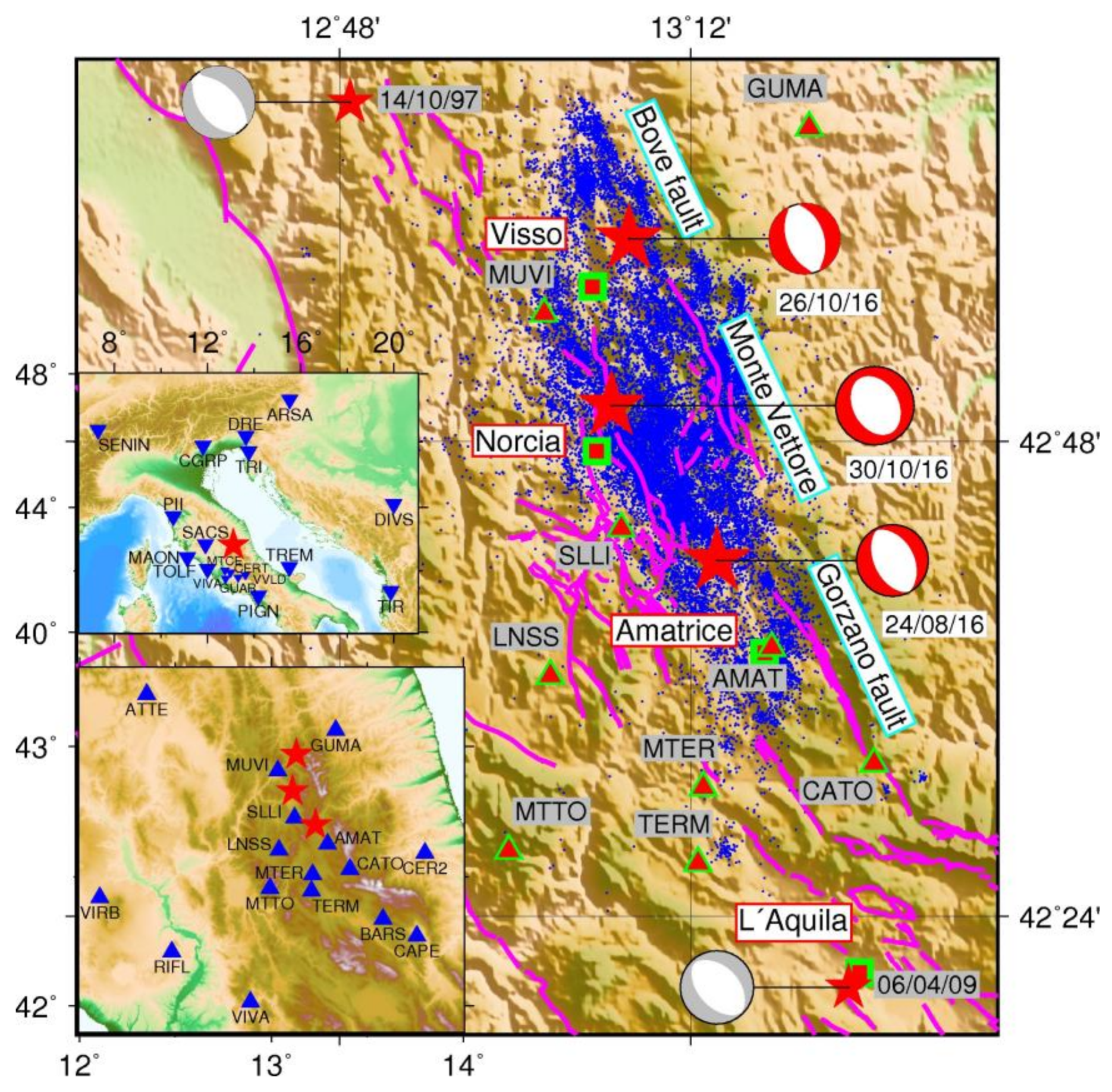
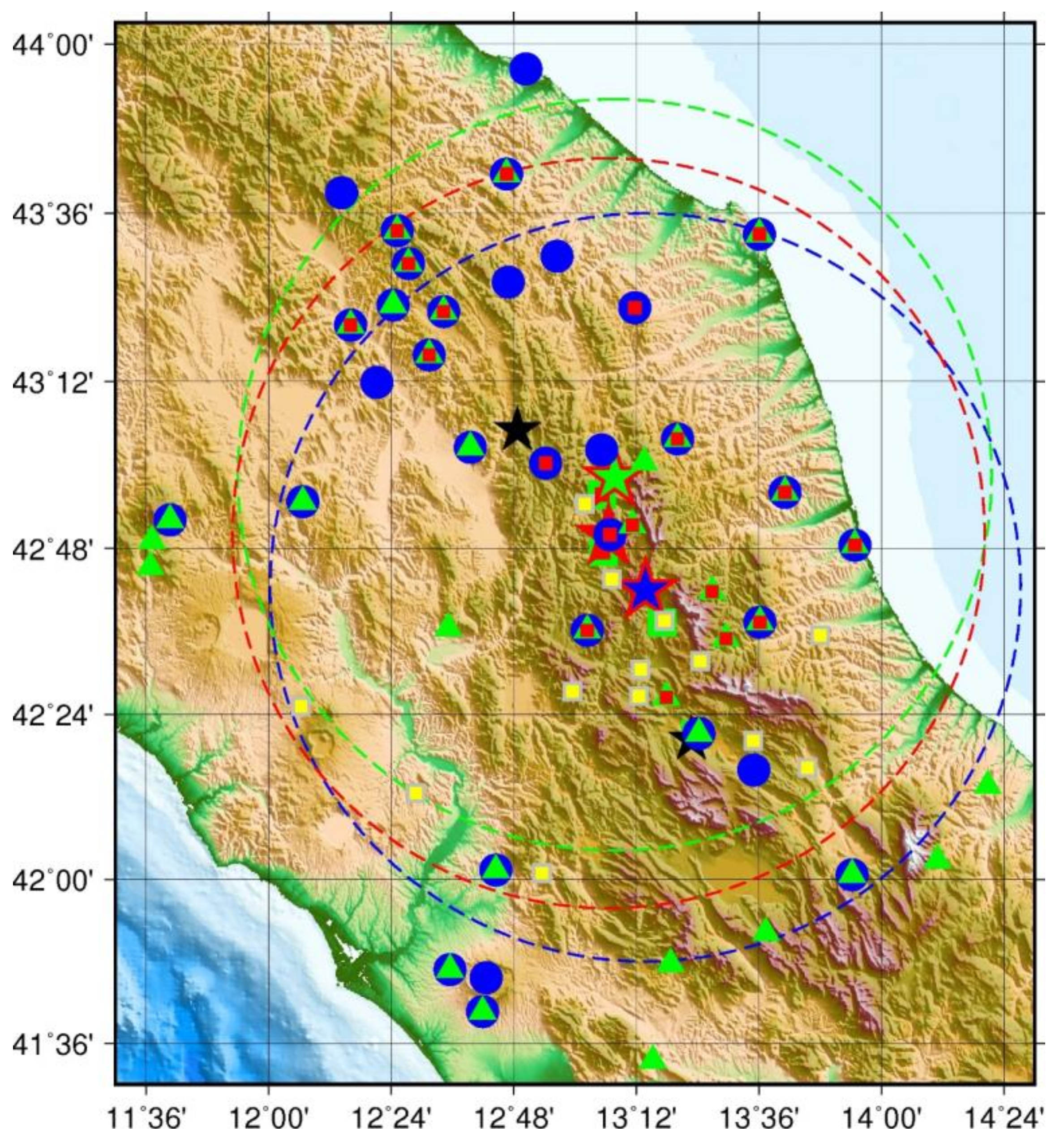

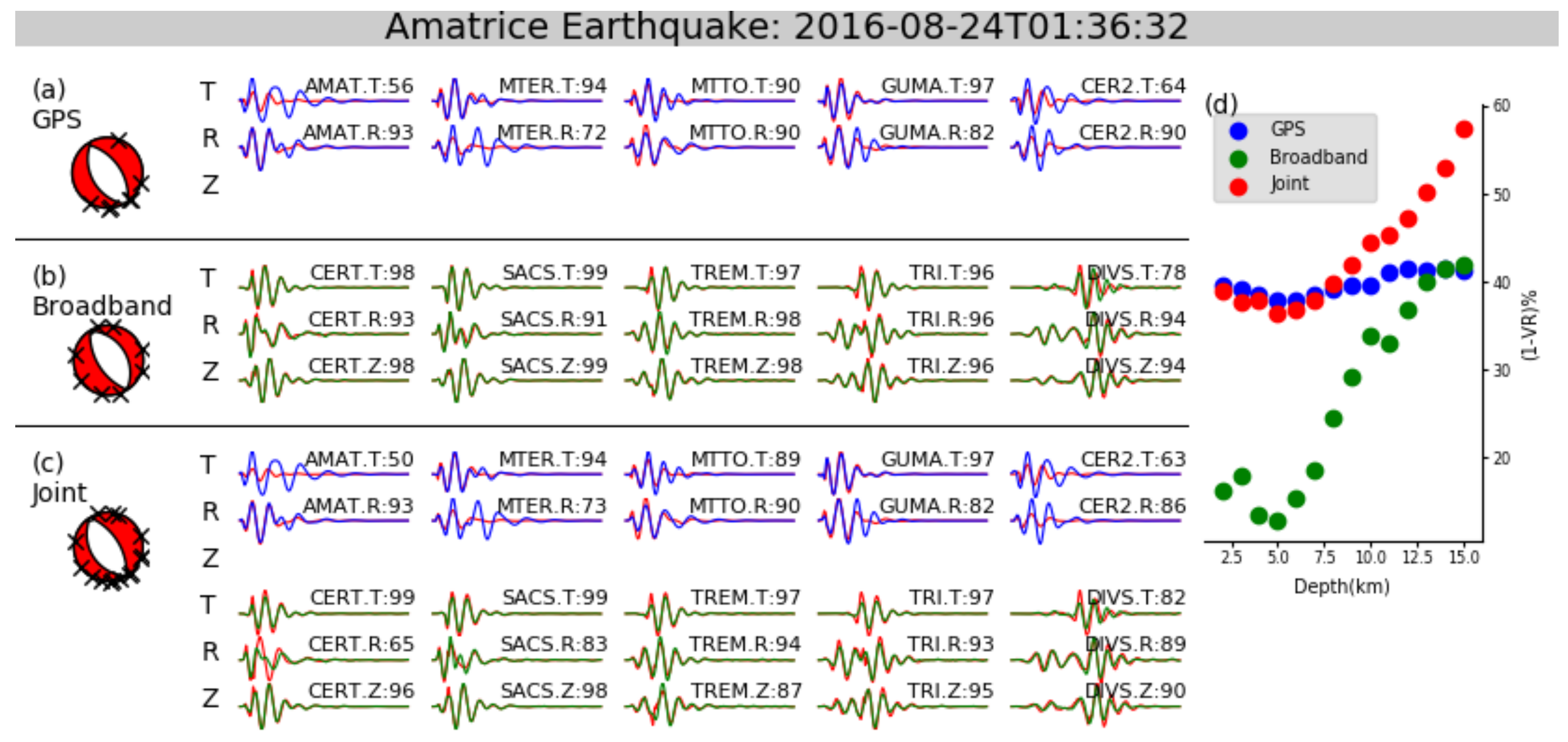
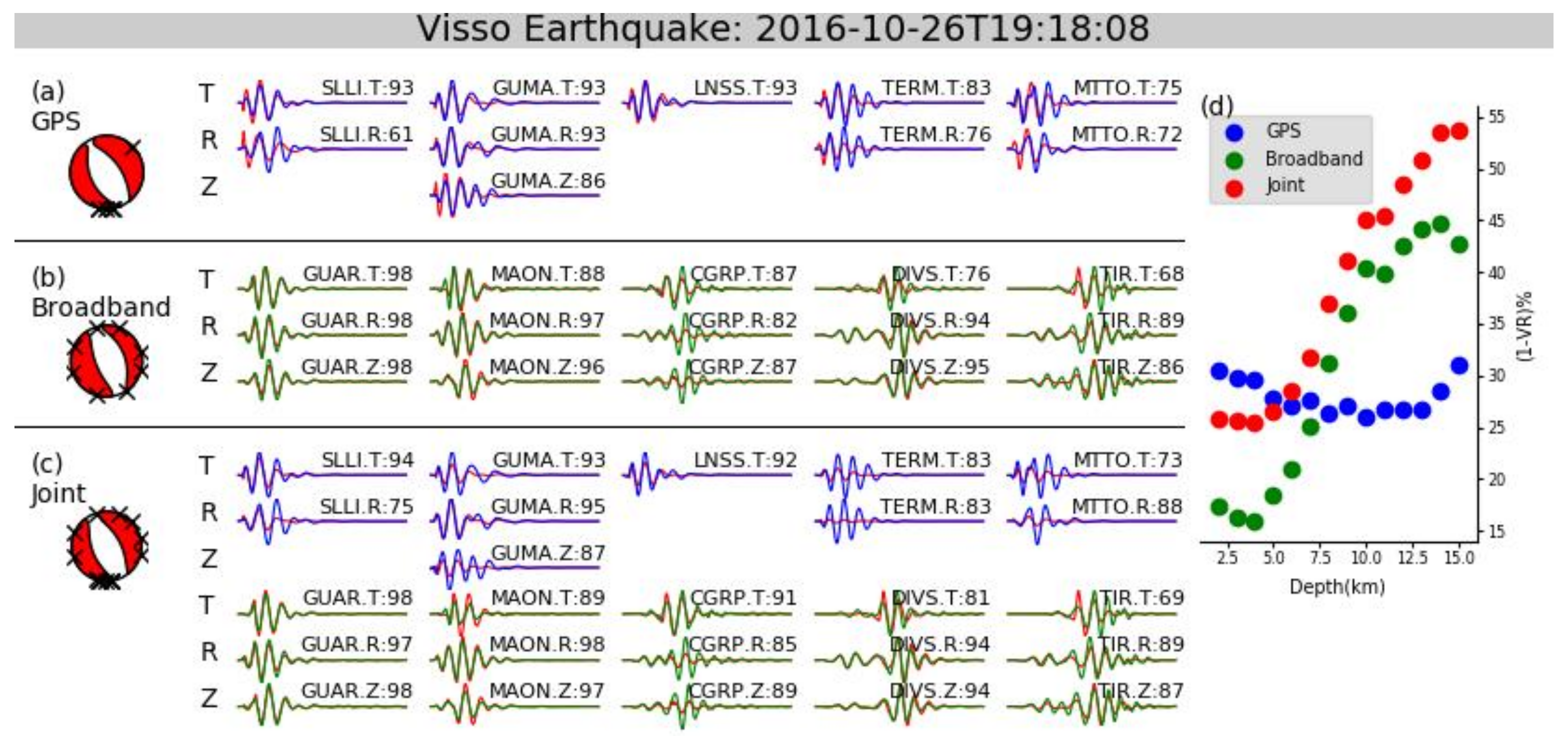

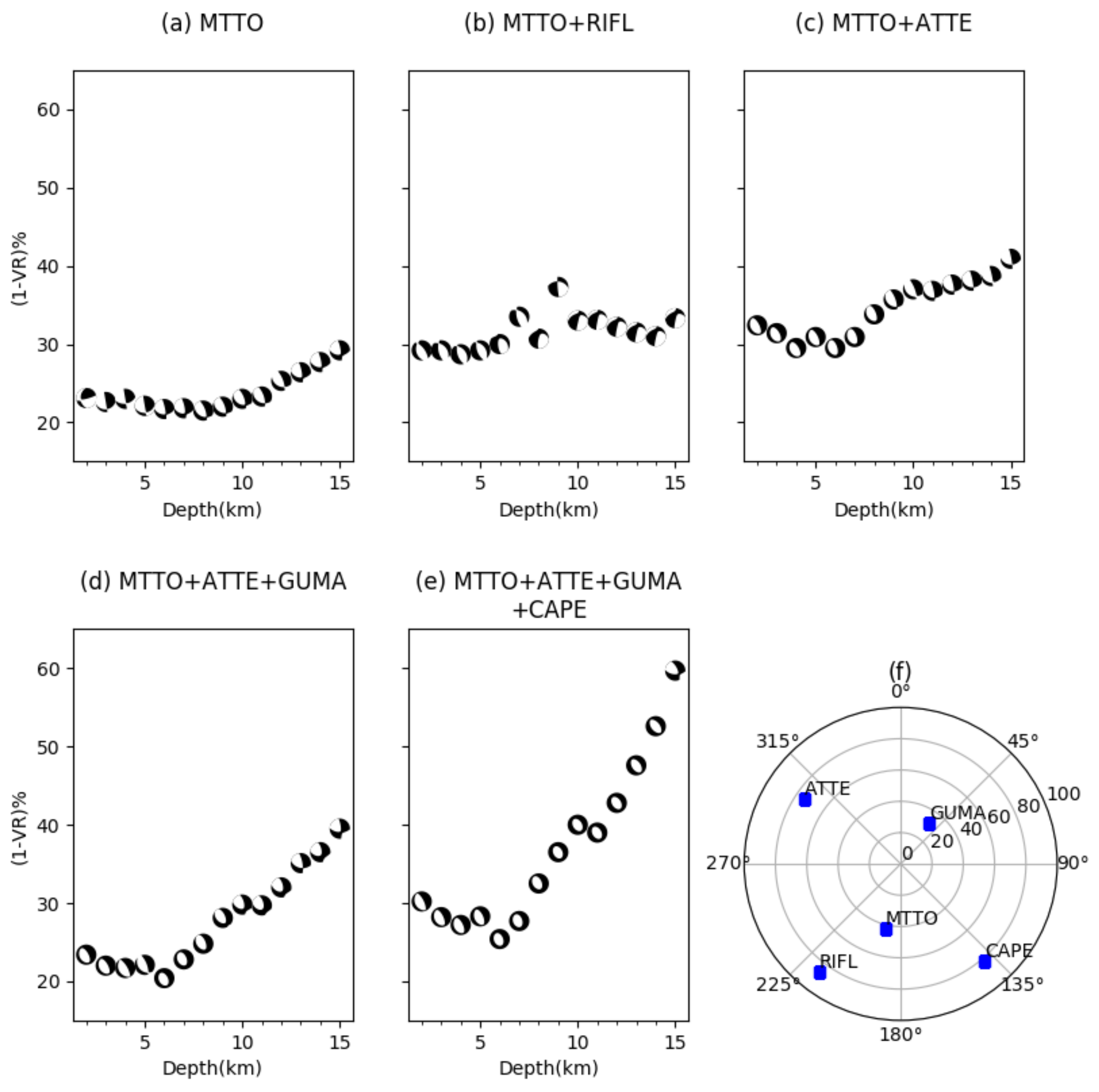
| Options | Values |
|---|---|
| Sampling rate | 10 Hz |
| Time span | Origin time ±3 min |
| Troposphere mapping function | VMF1 GRID |
| Troposphere parameter model | Random Walk 5×10-8 km/s |
| Troposphere delay gradient | 5×10-9 km/s0.5 |
| Ionosphere correction | CODE IONEX |
| Orbit and clock product | JPL Final |
| Stochastic model | White Noise 1×10-3 km |
| Thickness | |||
|---|---|---|---|
| 0.5 | 4.03 | 2.30 | 2.323 |
| 0.5 | 3.81 | 2.18 | 2.287 |
| 0.5 | 3.73 | 2.13 | 2.271 |
| 1 | 4.54 | 2.59 | 2.398 |
| 1 | 5.16 | 2.95 | 2.532 |
| 1 | 5.58 | 3.18 | 2.616 |
| 3 | 5.69 | 3.25 | 2.637 |
| 3 | 5.38 | 3.05 | 2.576 |
| 4 | 6.05 | 3.43 | 2.714 |
| 5 | 5.51 | 3.15 | 2.602 |
| 5 | 6.16 | 3.52 | 2.747 |
| 5 | 5.76 | 3.29 | 2.651 |
| 6 | 6.42 | 3.62 | 2.828 |
| 8 | 7.35 | 4.13 | 3.090 |
| - | 7.90 | 4.40 | 3.276 |
| Event | Source | Moment (N·m) | Mw 1 | Strike (°) | Dip (°) | Rake (°) | Depth (km) | DC% | VR% |
|---|---|---|---|---|---|---|---|---|---|
| Amatrice | USGSW 2 | 2.45×1018 | 6.2 | 165 | 49 | −78 | 11.5 | 86 | - |
| GCMT | 2.48×1018 | 6.2 | 145 | 38 | −101 | 12 | 96 | ||
| INGV | 1.07×1018 | 6 | 155 | 49 | −87 | 5 | 98 | ||
| GPS | 2.21×1018 | 6.2 | 152 | 40 | −84 | 6 | 100 | 62.2 | |
| Broadband | 1.42×1018 | 6.1 | 148 | 55 | −90 | 5 | 100 | 87.1 | |
| Joint | 1.95×1018 | 6.13 | 146 | 37 | −90 | 6 | 100 | 63.2 | |
| Visso | USGSW | 1.84×1018 | 6.1 | 155 | 50 | −89 | 11.5 | 90 | - |
| GCMT | 1.61×1018 | 6.1 | 152 | 35 | −94 | 12 | 92 | ||
| INGV | 7.38×1017 | 5.9 | 159 | 47 | −93 | 6 | 96 | ||
| GPS | 2.79×1018 | 6.23 | 158 | 40 | −78 | 10 | 97 | 74 | |
| Broadband | 1.00×1018 | 5.93 | 158 | 55 | −90 | 4 | 91 | 84 | |
| Joint | 1.02×1018 | 5.94 | 161 | 44 | −82 | 4 | 90 | 74.5 | |
| Norcia | USGSW | 1.07×1019 | 6.6 | 162 | 27 | −84 | 15.5 | 82 | - |
| GCMT | 9.58×1018 | 6.6 | 154 | 37 | −96 | 12 | 85 | ||
| INGV | 7.07×1018 | 6.5 | 151 | 47 | −89 | 5 | 68 | ||
| GPS | 9.45×1018 | 6.58 | 165 | 32 | −90 | 4 | 66 | 69.6 | |
| Broadband | 8.07×1018 | 6.54 | 163 | 58 | −90 | 5 | 69 | 86 | |
| Joint | 8.19×1018 | 6.54 | 161 | 33 | −90 | 4 | 71 | 70.4 |
| Test No. | Moment (N·m) | Mw | Strike (°) | Dip (°) | Rake (°) | Depth (km) | DC% | VR% |
|---|---|---|---|---|---|---|---|---|
| 1 | 7.31×1018 | 6.51 | 119 | 30 | −128 | 8 | 98 | 78.8 |
| 2 | 8.70×1018 | 6.56 | 161 | 56 | −80 | 4 | 99 | 71.3 |
| 3 | 9.60×1018 | 6.59 | 159 | 25 | −80 | 4 | 82 | 70.5 |
| 4 | 9.04×1018 | 6.57 | 159 | 33 | −82 | 6 | 66 | 79.6 |
| 5 | 9.80×1018 | 6.59 | 157 | 33 | −90 | 6 | 60 | 74.6 |
| GPS ALL | 9.45×1018 | 6.58 | 165 | 32 | −90 | 4 | 66 | 69.6 |
| INGV | 7.07×1018 | 6.5 | 151 | 47 | −89 | 5 | 68 | - |
© 2018 by the authors. Licensee MDPI, Basel, Switzerland. This article is an open access article distributed under the terms and conditions of the Creative Commons Attribution (CC BY) license (http://creativecommons.org/licenses/by/4.0/).
Share and Cite
Zhong, S.; Xu, C.; Yi, L.; Li, Y. Focal Mechanisms of the 2016 Central Italy Earthquake Sequence Inferred from High-Rate GPS and Broadband Seismic Waveforms. Remote Sens. 2018, 10, 512. https://doi.org/10.3390/rs10040512
Zhong S, Xu C, Yi L, Li Y. Focal Mechanisms of the 2016 Central Italy Earthquake Sequence Inferred from High-Rate GPS and Broadband Seismic Waveforms. Remote Sensing. 2018; 10(4):512. https://doi.org/10.3390/rs10040512
Chicago/Turabian StyleZhong, Shuhan, Caijun Xu, Lei Yi, and Yanyan Li. 2018. "Focal Mechanisms of the 2016 Central Italy Earthquake Sequence Inferred from High-Rate GPS and Broadband Seismic Waveforms" Remote Sensing 10, no. 4: 512. https://doi.org/10.3390/rs10040512





